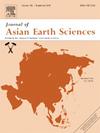Geochemical evidence for Late Eocene to Oligocene climate change in the Lühe Basin of the southeastern Tibetan Plateau
IF 2.7
3区 地球科学
Q2 GEOSCIENCES, MULTIDISCIPLINARY
引用次数: 0
Abstract
The transition from the Eocene to the Oligocene marks a critical phase in Earth’s history, characterized by a shift from greenhouse to icehouse conditions. While global climate changes during this period have been extensively studied, continental geological evidence particularly from landmasses such as the Tibetan Plateau (TP) and its surrounding regions remained limited. Addressing this research gap, our study employs high-resolution trace element geochemical records from the Lühe Basin at the southeastern margin of the Tibetan Plateau (SEMTP) to systematically investiate sediment provenance and weathering processes from the Late Eocene to the Oligocene (35.5–25.5 Ma). The results indicate that the sediment provenance in the Lühe Basin shows limited variation across different scales of provenance analysis, and lithological have little effect on the reconstruction of chemical weathering records. Based on various geochemical proxies, three distinct phases in the evolution of weathering are identified: (1) a phase of progressively intensified weathering during the Late Eocene, (2) a marked decline in weathering intensity during the Eocene-Oligocene Transition (EOT), and (3) a phase of recovery followed by sustained fluctuations in the Oligocene. Furthermore, we discuss the potential global climatic and regional environmental drivers underlying each phase.

青藏高原东南部河盆地晚始新世—渐新世气候变化的地球化学证据
从始新世到渐新世的过渡标志着地球历史的一个关键阶段,其特点是从温室条件到冰室条件的转变。虽然这一时期的全球气候变化已被广泛研究,但大陆地质证据,尤其是来自青藏高原(TP)等陆地及其周边地区的证据仍然有限。针对这一研究空白,我们的研究利用青藏高原东南缘吕河盆地(SEMTP)的高分辨率痕量元素地球化学记录,系统研究了晚始新世至渐新世(35.5-25.5Ma)的沉积物来源和风化过程。结果表明,吕梁盆地沉积物产状在不同尺度的产状分析中变化有限,岩性对化学风化记录的重建影响不大。根据各种地球化学代用指标,确定了风化演化的三个不同阶段:(1)晚始新世风化逐渐加剧的阶段;(2)始新世-渐新世过渡(EOT)时期风化强度明显下降的阶段;(3)渐新世持续波动之后的恢复阶段。此外,我们还讨论了每个阶段背后潜在的全球气候和区域环境驱动因素。
本文章由计算机程序翻译,如有差异,请以英文原文为准。
求助全文
约1分钟内获得全文
求助全文
来源期刊

Journal of Asian Earth Sciences
地学-地球科学综合
CiteScore
5.90
自引率
10.00%
发文量
324
审稿时长
71 days
期刊介绍:
Journal of Asian Earth Sciences has an open access mirror journal Journal of Asian Earth Sciences: X, sharing the same aims and scope, editorial team, submission system and rigorous peer review.
The Journal of Asian Earth Sciences is an international interdisciplinary journal devoted to all aspects of research related to the solid Earth Sciences of Asia. The Journal publishes high quality, peer-reviewed scientific papers on the regional geology, tectonics, geochemistry and geophysics of Asia. It will be devoted primarily to research papers but short communications relating to new developments of broad interest, reviews and book reviews will also be included. Papers must have international appeal and should present work of more than local significance.
The scope includes deep processes of the Asian continent and its adjacent oceans; seismology and earthquakes; orogeny, magmatism, metamorphism and volcanism; growth, deformation and destruction of the Asian crust; crust-mantle interaction; evolution of life (early life, biostratigraphy, biogeography and mass-extinction); fluids, fluxes and reservoirs of mineral and energy resources; surface processes (weathering, erosion, transport and deposition of sediments) and resulting geomorphology; and the response of the Earth to global climate change as viewed within the Asian continent and surrounding oceans.
 求助内容:
求助内容: 应助结果提醒方式:
应助结果提醒方式:


